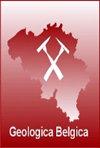New Rugose corals and refinements of the Tournaisian biostratigraphy of the Donets Basin (Ukraine)
IF 0.7
4区 地球科学
Q2 GEOLOGY
引用次数: 1
Abstract
1. IntroductionIn the Donets Basin (Ukraine) the Tournaisian rocks are commonly fossiliferous carbonates. A detailed lithostratigraphic and biostratigraphic division has been achieved over the last decades (Aizenverg et al., 1963; Poletaev et al., 1990; Poletaev et al., 2011). Rugose and tabulate corals are widely distributed in some part of the sections. M.I. Lebedev and K.I. Lisitzin first identified Tournaisian corals of the Donbas early in the 20th century and used these fossils as guides to divide the sections and to correlate them with England and Belgium. I.I. Gorsky and V.D. Fomichev studied the Early Carboniferous corals of the Donets Basin during the 1920’s, but their studies have never been completed, and their collections were lost. Only brief and limited results of these studies have been published by Fomichev (1953) and Vassilyuk (1960). Vassilyuk studied the Early Carboniferous corals of the Donets Basin in detail and has proposed a coral zonation for the Lower Carboniferous strata (Poletaev et al., 1990). The stratigraphic distribution of corals taxa in the Tournaisian strata is highly heterogeneous. Most corals are found in the middle part of the Tournaisian (C1tc Zone) (Ogar, 2010). In the lower and upper parts of the Tournaisian, corals are much rarer. Unexpected new findings are reported in this paper, together with the redescription of specimens from Vassiljuk’s collection.2. SettingsThe southern part of the Donets Basin is the only area in Ukraine where新Rugose珊瑚与乌克兰顿涅茨盆地Tournaisian生物地层学的改进
1. 在顿涅茨盆地(乌克兰),图尔奈岩通常是化石碳酸盐。在过去的几十年里,已经完成了详细的岩石地层和生物地层划分(Aizenverg et al., 1963;Poletaev et al., 1990;Poletaev et al., 2011)。斑纹珊瑚和表纹珊瑚广泛分布于部分剖面。M.I. Lebedev和K.I. Lisitzin在20世纪早期首次发现了顿巴斯的Tournaisian珊瑚,并利用这些化石作为划分部分的指南,并将它们与英格兰和比利时联系起来。I.I. Gorsky和V.D. Fomichev在20世纪20年代研究了顿涅茨盆地的早石炭纪珊瑚,但他们的研究从未完成,他们的藏品也丢失了。Fomichev(1953)和Vassilyuk(1960)只发表了这些研究的简短和有限的结果。Vassilyuk详细研究了顿涅茨盆地早石炭世的珊瑚,并提出了下石炭世地层的珊瑚分带(Poletaev et al., 1990)。图尔尼斯地层中珊瑚类群的地层分布具有高度的不均匀性。大多数珊瑚位于Tournaisian (C1tc带)的中部(Ogar, 2010)。在Tournaisian的下部和上部,珊瑚要稀有得多。本文报道了意想不到的新发现,并对Vassiljuk收集的标本进行了重新描述。顿涅茨盆地的南部是乌克兰唯一一个
本文章由计算机程序翻译,如有差异,请以英文原文为准。
求助全文
约1分钟内获得全文
求助全文
来源期刊

Geologica Belgica
地学-地质学
CiteScore
4.70
自引率
27.80%
发文量
8
审稿时长
>12 weeks
期刊介绍:
Geologica Belgica is a Belgian journal that welcomes papers concerning all aspects of the earth sciences, with a particular emphasis on the regional geology of Belgium, North West Europe and central Africa. Papers not dedicated to the geology of Belgium, North West Europe and central Africa are only accepted when one of the authors is linked to a Belgian University or Institution. Thematic issues are highly appreciated. In this case, guest editors take in charge the selection of the manuscripts and the subject of the papers can be enlarged. The journal is in open access.
Submitted manuscripts should be concise, presenting material not previously published. The journal also encourages the publication of papers from Belgian junior authors. Short letters are accepted. Papers written in English are preferred. Each mansucript will be reviewed by at least two reviewers.
 求助内容:
求助内容: 应助结果提醒方式:
应助结果提醒方式:


